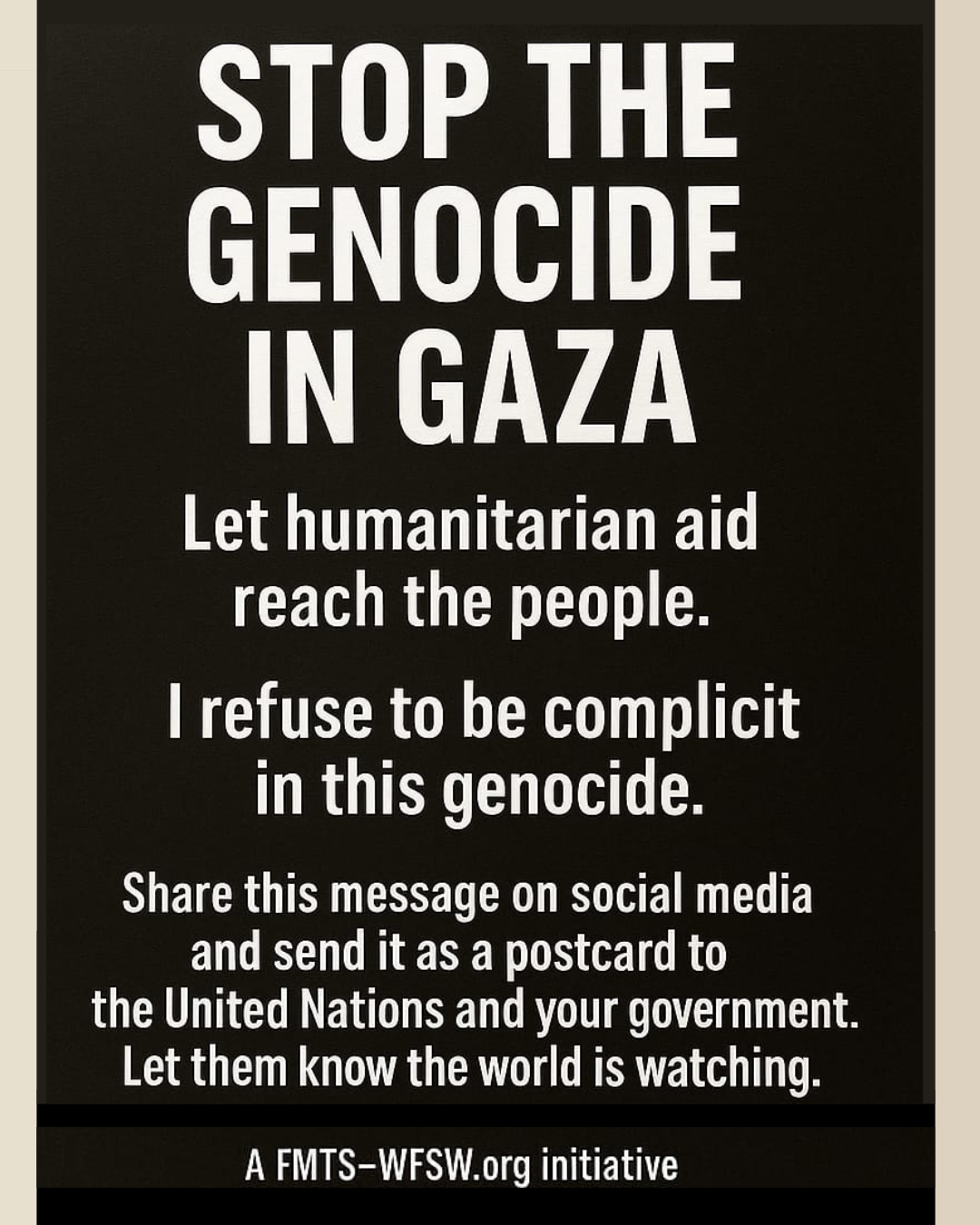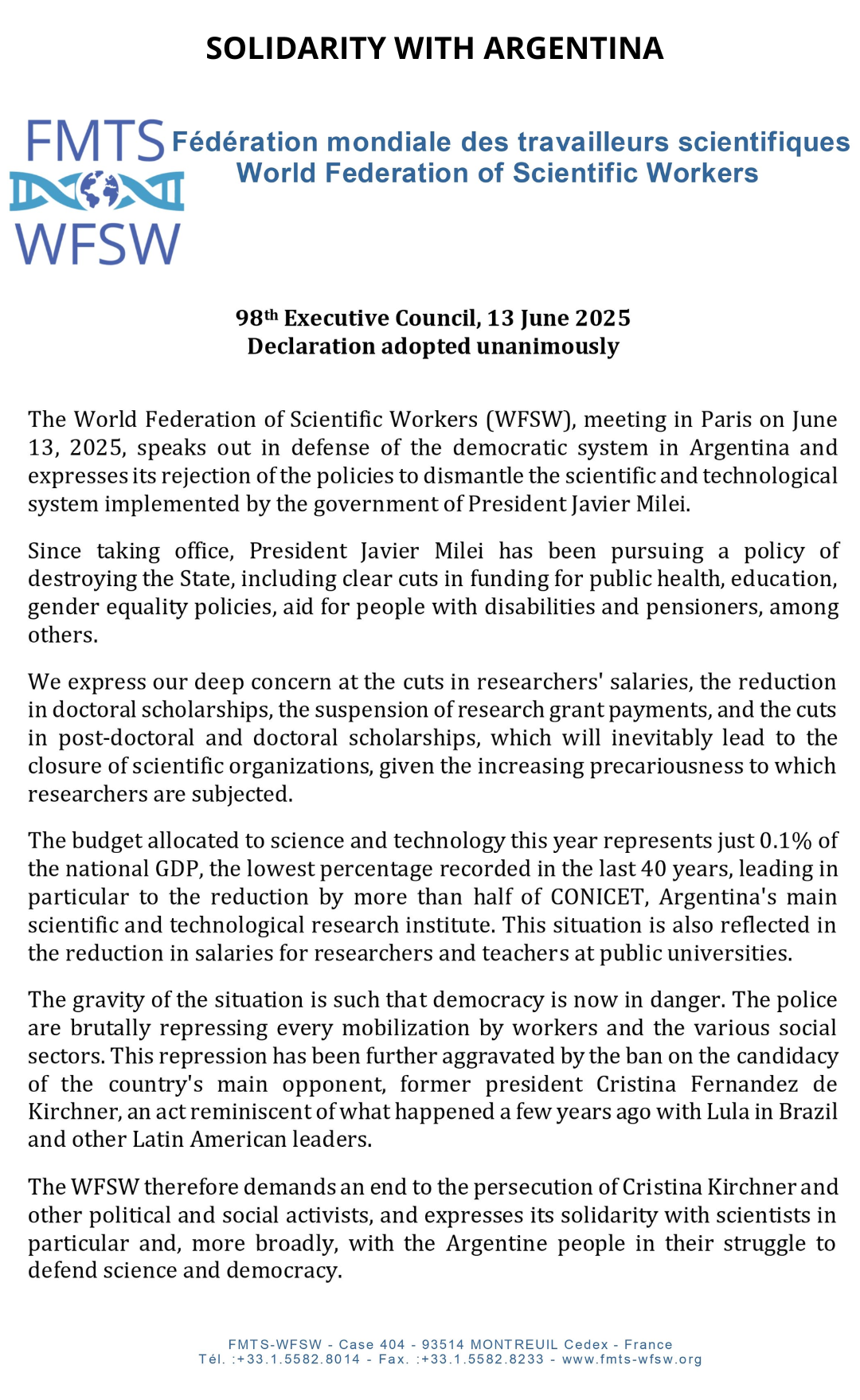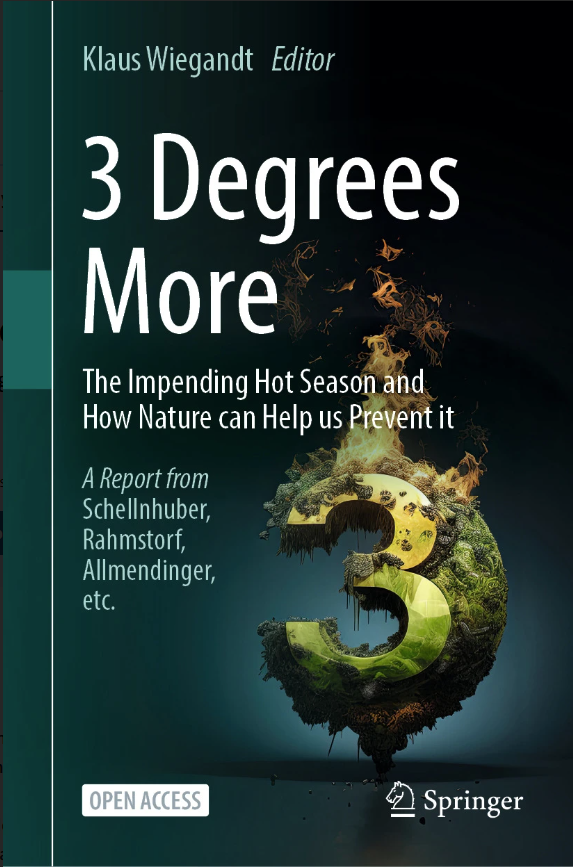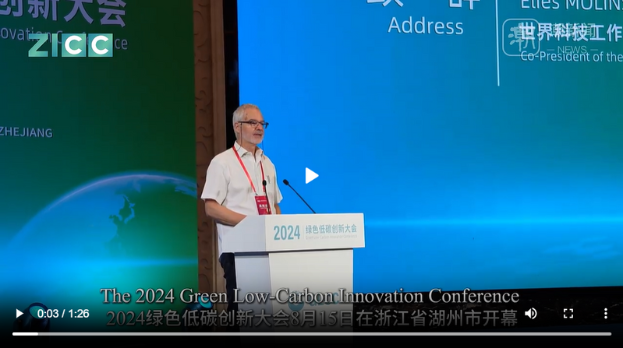War-Climate Interactions
EXISTENTIAL RISKS: THE CASE OF WAR-CLIMATE INTERACTIONS
94th Executive Council Meeting of the WFSW
Évora (Portugal) July 2—7, 2023
Contribution to the debates at Working Group: “Peace, Disarmament and Cooperation”
Frederico Carvalho
OTC-Organisation of Scientific Workers, Portugal
THE DOOMSDAY CLOCK
The Doomsday Clock is a symbol that represents the likelihood of a human-made global catastrophe. One should understand under “global catastrophe” an event or a succession of related events that would inflict large-scale damage to human societies and even lead to the extinction of life on Earth. The time delay separating us from the instant when the catastrophe becomes unavoidable is given by the position of the hands of the symbolic clock. The Doomsday Clock is a powerful symbol born in the year 1947 shortly after the atomic bombings of the Japanese cities of Hiroshima and Nagasaki one of the several war crimes that were perpetrated during the Second World War. An international group of scientists who had participated in the Manhattan Project created the symbol as a means to raise public awareness of the dreadful consequences of un unchecked use of the technological advances they had contributed to. Immediately after, the Doomsday Clock was adopted by the Bulletin of Atomic Scientists founded by members of that group.
The eruption of a hypothetical global catastrophe is represented by midnight on the clock, with the Bulletin’s opinion on how close the world is to one represented by a certain number of minutes or seconds to midnight, as assessed in January of each year. In January 2022 the hands of the Clock showed 90 seconds to midnight. And at 90 seconds to midnight they remain since then. We do not anticipate how they will be moved in January next year. But the prospects are not good.[1]
 Jamie Christiani/Bulletin of the Atomic Scientists
Jamie Christiani/Bulletin of the Atomic Scientists
Since its inception in the year of 1947 the threat of nuclear annihilation was at the centre of the preoccupations of the group responsible for the setting of the position of the hands of the Doomsday Clock. In the course of the last decade of the past century and definitely from the year 2007 on, climate change was added to the prospect of nuclear annihilation as one of the greatest threats to mankind.
Although nuclear risk and climate change remain the main factors influencing the Clock new advances in scientific knowledge and emerging technological applications that could inflict irrevocable harm to humanity are regularly monitored by the Bulletin’s Science and Security Board. Included are among others the development at a rapid pace of certain so-called disruptive technologies, namely gene editing techniques, advances in information technology, cybernetics or artificial intelligence.
The unregulated use of such technologies may lead to the emergence of new ways of waging war, controlling human behaviour and upsetting balances of power between nations, with serious consequences for Peace.
We believe in the importance of making our fellow citizens aware of the threats that face us. It is our duty as scientific workers to act responsibly in that direction. This is not an easy task when living in an environment where an “information war” rages.
Four years ago, Rachel Bronson, President of the Science and Security Board of the Bulletin of Atomic Scientists branded the current world security situation as a “new abnormal.” She wrote (quote): “The new abnormal describes a moment in which fact is becoming indistinguishable from fiction, undermining our very abilities to develop and apply solutions to the big problems of our time. The new abnormal risks emboldening autocrats and lulling citizens around the world into a dangerous sense of anomie and political paralysis”.[2]
The threat of information warfare is very real in our days. An effort is necessary from our side — scientific workers — to devise and practice intelligent forms of combat against that threat.
HOW DOES WAR CONTRIBUTE TO CLIMATE CHANGE?
As it becomes consensual to consider climate change in pair with the prospect of nuclear war as one of the two single most dangerous immediate threats to the survival of human societies on a planet with life-supporting conditions or, in other words, the conditions under which organized life remains possible, it is natural to question the effects of multiple
conventional military conflicts currently referred to as conventional warfare.
Conventional conflict
CO2 is the largest contributor to the total greenhouse gas (GHG) emissions: it accounts for about ¾ of the total. Military carbon emissions represent a non-negligible fraction of the carbon footprint of human activities, that is, the amount of greenhouse gases (including CO2 and methane) released into the atmosphere as a result of those activities. Estimating a global total for the carbon footprint of the military is not an easy task. Available data is scarce and incomplete. There are good reasons for it.
The 1997 Kyoto Protocol which set carbon emission reduction targets for industrialized nations for the first time, implied several compromises. One of them was that emissions of military forces would be excluded from the targets agreed upon. The US lead negotiator later stated that at Kyoto the delegation had achieved everything the US Defense Department had outlined as necessary to “protect military operations”. Namely “exempt key overseas military activities from any emissions targets, including exemptions for bunker fuels used in international aviation and maritime transport and from emissions resulting from multilateral operations.” [3]
Years later, in 2015, the negotiated exemption formally disappeared from the Paris Climate Agreement operating rules. In fact, it was just an indulgence in make-believe as the decision to include or not include military carbon emissions is left to the will of individual countries.
A realistic assessment of the contribution of the military and of warfare to GHG emissions has to include emissions from several sources. The one that comes immediately to mind is that tied to actual war-fighting, that is the one arising from the consumption of fossil fuels required for the operation of all kinds of vehicles on air land and sea as the war is
fought. However. as pointed out by Dr. Stuart Parkinson emissions resulting from the direct use of military equipment in a war theater are only part of the story [4]. In fact, carbon emissions of the arms industry that produces the military equipment, as well as those attached to the extraction of the raw materials used by that industry should be counted as well. The total emissions including all aspects related to military operations should also consider fuel consumption associated with routine maintenance and operation of military bases and other military establishments. It is safe to say that the weight of these peacetime components of GHG emissions in the total military emissions is particularly significant in the case of the world’s largest military spenders, i. e., and in that order, the USA, China, Russia, India and Saudi Arabia. The USA is by far the largest spender [5]. According to Neta C. Crawford of Boston University [6], military establishments that “support US operations and power projection capability” include “more than 560,000 facilities with over 275,000 buildings at 800 bases located on about 27 million acres[7] of land in the US and across the globe” [8].
At this point it is fair to say that other large military spenders are much less transparent in what concerns the data made available to estimate their respective military carbon emissions.
When a war is fought the war impacts on climate change and the environment go far beyond the direct result of the fact that the amount of GHG emissions is inevitably increased as a consequence of the necessary supply of energy required to keep the war machine going. Other immediate and long-term societal impacts have to be considered.
A brief summary of such impacts should include [9]
• Oil fires caused by weapons use;
• Fires caused by the bombing of urban areas;
• Carbon emissions from vegetation fires in conflict areas, mainly deforestation;
• Health care for survivors (civilian/military);
• Post-conflict reconstruction: carbon costs of debris management, the remediation of contaminated areas and reconstruction;
• Radical and in some cases long-lasting land use changes and increased emergency recourse to polluting energy sources (coal and wood, mainly).
Dr. Stuart Parkinson, Executive Director of the independent UK-based membership organization “Scientists for Global Responsibility” who has extensively written on the subject we are dealing with, estimates that the total military carbon footprint could be 6% of the total worlds carbon footprint which is about 37 Gt of CO2 equivalent. As he points out, “this would make it a more polluting sector than, for example, civil aviation” [10].
We believe that research should be encouraged in the development of methodologies to evaluate the climatic costs of what we understand by conventional warfighting. Conservative estimates of the contribution of the military to GHG emissions show that such emissions in fact, tend to nullify the meager advances obtained through the application of international agreements aimed at reducing emissions.
According to a report by Oil Change International [11] the Iraq war was responsible for 141 million tons of carbon releases in its first four years. On an annual basis, this was more than the emissions from 139 countries in this period, or about the same as putting an extra 25 million cars on to US roads for a year. The paper found that projected US
spending on the Iraq war could cover all global investments in renewable energy needed to halt global warming trends in the period to 2030. [12]
In the next section we shall deal with the climatic effects of nuclear war. Already at this point we wish to emphatically express the conviction that conventional war is incompatible with the success of any mitigating efforts to effectively combat the threat posed by climatic change. Thus, following the path defined by pursuing “business as usual” — which
includes war — is in itself an existential threat to humanity. Survival will depend on revolutionary societal changes, abolishing war, establishing peace.
Nuclear war
The possibility of a nuclear war cannot be excluded. The assertion that “a nuclear war cannot be won and should never be fought” dates back to the 1980s when Ronald Reagan and Mikhail Gorbachev met at the Geneva Summit in 1985. It was taken up recently by Joe Biden as he addressed the United Nations General Assembly in September 2022[13]. Simultaneously we are witnessing the development of a renewed arms race that includes the development of improved versions of nuclear explosives and of their launch vectors. It is also recalled that in January 2022 the five nuclear powers with a permanent seat on the United Nations Security Council issued a joint declaration that mirrors Reagan and Gorbachev’s position. In 2017 the United Nations General Assembly adopted the The Treaty on the Prohibition of Nuclear Weapons. The Treaty entered into force in January 2021. However, none of the present nine nuclear powers has signed the Treaty. During the negotiations, no nuclear-armed nation expressed support for a ban treaty; indeed, a number of them, including the United States and Russia, have expressed explicit opposition. Moreover, following the treaty’s adoption, the permanent missions of the United States, the United Kingdom and France issued a joint statement indicating that they did not intend “to sign, ratify or ever become party to it”.
In this context it is also worth noting that no steps have been taken toward putting into practice the provisions of Article 6 of the Treaty on the Non-Proliferation of Nuclear Weapons. And last but not least, in the course of the past 20 years the complex of RussiaUnited States bilateral treaties that imposed limitations on the composition in number and quality of the nuclear arsenals of the signatory parties has been consistently dismantled.
The present geopolitical scene where we witness a multiform global confrontation of major world powers does not favor much optimism about the future.
Indeed, some well-placed observers, believe that in the global US defense establishment — and we have in mind: the military, government, think tanks, and industry— many promote the perception that a nuclear war can be won and fought. [14] The authors cited here add: “Moreover, they do so in a voice that is influential, respected, well-funded, and
treated with deference. The US defense leadership’s methodical messaging to its workforce helps shape the views of this massive, multi-sector constituency that includes advocates, future leaders, and decision-makers. It advances a view of nuclear weapon policies that intensifies and accelerates the new nuclear arms race forming between the United States, China, and Russia”.
However, many experts believe, as we do, that “a limited nuclear war is unlikely to remain limited. What starts with one tactical nuclear strike or a tit-for-tat nuclear exchange between two countries could escalate to an all-out nuclear war ending with the immediate and utter destruction (of the belligerent parties)”[15].
Such a scenario is compatible with the extinction of life on the planet at least of its more complex forms.
Effects of a single nuclear explosion
Let us consider the effects of the deflagration in the air at, say, about 800 m above the ground, of a single nuclear explosive of 300 kt TNT equivalent — a value about ten times the combined power of the bombs dropped on Hiroshima and Nagasaki [16].
The nuclear explosion has immediate, short term and long-term effects. Immediate effects are the consequence of nuclear reactions inside the bomb that lead to the direct radiation of mainly highly energetic gamma rays and fast neutrons that lasts during a fraction of a second. In the case of the 300 kt TNTe explosive lethal consequences of this short-lived radiation burst can be felt inside an area of about 2 kms radius from the so-called ground zero.
Within a few microseconds after the explosion, part of the energy is released in the form of X-rays. The X-rays cause an intense heating of the air in the surrounding environment. Within a few seconds a fireball of superheated air is created inside which a hot plasma is formed due to the extreme temperature and pressure. The temperature is similar to the temperature in the core of the sun (10 MC). The fireball ascends in the air later on originating the widely known “mushroom cloud”. It may grow to more than 600 m in diameter and remains intensely bright for several seconds. It will cause blindness of the unprotected eye. It will also ignite fires and cause severe burns as far as 13 km from ground zero.[17]
The fireball superheats the atmosphere around it. As a consequence, the air expands outwards forming a powerful shockwave of great destructive power that starts moving away from the explosion site at a speed that is initially faster than the speed of sound but rapidly slowing down as it transfers energy to the surrounding layers of the atmosphere. Less than 10 seconds after the explosion at about 5 km from ground zero a 0.3-atmosphere overpressure of the air is still sufficient to destroy most buildings and large structures and cause widespread fatalities.
As the fireball rises in the atmosphere it cools down becoming the head of the well-known mushroom-shaped cloud. The cloud transports a large number of a variety of highly radioactive atoms formed during the explosion as a result of nuclear reactions occurring inside the structural materials of the bomb casing. As the cloud is blown by the wind these
radioactive “ashes” begin falling to the ground spreading radioactive contamination over large areas of soil. In the case of a 300 kt weapon the contaminated area can encompass thousands of square kilometers downwind of the detonation site. Apart from the rather short-lived danger of direct external irradiation of the body there is a long-term biological risk associated with the possible inhalation of radioactive dust or the ingestion of contaminated water or foods.
The case of a nuclear conflict
When speaking of “nuclear conflict” we have in mind an exchange of nuclear weapons launched by at least two competing nuclear-armed powers. We wish to focus on the longterm consequences of such a conflict that is known as “nuclear winter”. The concept of nuclear winter arose in the 80’s of last century as a few scientists both from the then USSR and the USA researched the subject using the then-available models that allowed to predict the global climatic effects of deflagrating a number of nuclear explosives in a rapid sequence. American scientists first showed that a nuclear winter could occur from the smoke produced by the massive forest fires ignited by nuclear weapons after a nuclear war. Two Russian scientists later conducted the first three-dimensional climate modeling showing that global temperatures would drop lower on land than on oceans, potentially causing an agricultural collapse worldwide [18]. Results have shown the importance of pursuing these research efforts so as to obtain more accurate results justifying improved confidence.
Models have evolved with time and recent calculations show that the effects of nuclear war would be more long-lasting and worse than previously thought.
Regrettably it is apparent that poor attention is given to the phenomenon of nuclear winter by the ruling circles of the main powers. Decision-makers and the public may be ignorant of the most serious global climate consequences of a nuclear war, which could lead to global famines. Thus, bringing the dangers of nuclear war in a responsible way to the
attention of their fellow citizens is one of the main challenges facing socially responsible scientific workers.
We shall briefly present here the sequence of events that may lead to a nuclear winter catastrophe. In the following we have extensively used information collected from the excellent article from François Diaz-Maurin entitled “Nowhere to Hide. How a nuclear war would kill you — and almost everyone else”, published in The Bulletin of Atomic Scientists (see endnote [17] below).
A sequence of nuclear explosions will generate firestorms in populated areas as well as massive forest fires. Smoke from mass fires will inject massive amounts of soot[19] into the stratosphere, the Earth’s upper atmosphere. When smoke is injected into the lower stratosphere, it is heated by sunlight and lofted at high altitudes. Recent models used to simulate the phenomenon show that soot from nuclear firestorms would rise much higher into the stratosphere than once imagined, where soot removal mechanisms in the form of “black rains” are slow [20]. Once the smoke is heated by sunlight it can self-loft to altitudes as high as 80 kilometers penetrating the mesosphere [21]. Soot injected into the upper atmosphere can block sunlight from reaching the Earth’s surface leading to a decrease in temperatures that may remain abnormally low for several years in the case of a massive exchange of nuclear explosives.
In the stratosphere, the presence of highly absorptive black carbon aerosols would result in considerably enhanced stratospheric temperatures. This will lead to a depletion of the ozone layer which protects humans and other life on Earth from the severe health and environmental effects of ultraviolet radiation This effect could last for several years.
Changes in the atmosphere, surface, and oceans following a nuclear war will have massive and long-term consequences on global agricultural production and food availability.
Also, long-term direct impacts of radioactivity on humans or the widespread radioactive contamination of soils and foods that would follow a nuclear war have to be considered in addition to the aforementioned disruptive effects on the Earth systems.
The threshold of the number of weapon detonations needed to trigger nuclear winter is significantly lower than the available weapons in the world’s arsenals. The US is estimated to have a total destructive force (yield) within the whole nuclear arsenal (deployed and in storage) of just under 780 MT. Assuming that the Russians have a comparable total yield, then the three scenarios outlined in the Infographic below, account for 0.1%, 1.6% and 28% of the two states’ combined total nuclear arsenals.[22] As shown in the infograph the number of deaths by starvation can lie between 10 and 20 times the number of direct fatalities.

Frederico Carvalho
June 14, 2023
Portuguese version: https://otc.pt/wp/2023/09/14/guerra-e-clima/
Pdf document (English): EC94-12ENWG1EXISTENTIAL-RISKS-THE-CASE-OF-WAR-CLIMATE-INTERACTIONS
_______________________________________________________
[1]The setting of the hands of the Clock is jointly decided by the members of the so-called Bulletin’s Science and Security Board and a Board of Sponsors composed of accomplished science and security leaders from around the world that at present includes 10 Nobel laureates.
[2] https://thebulletin.org/doomsday-clock/2019-doomsday-clock-statement/
[3] https://www.sgr.org.uk/resources/carbon-boot-print-military-0
[4] See previous note
[5] Source: SIPRI. Data for 2022. The military expenditure of the USA corresponds to 60% of the total expenditure of the 5 countries total. The United Kingdom, Germany and France who are important producers and exporters of arms, come in 6th, 7th and 8th place, respectively.
[6] Neta C. Crawford is Professor and Chair of Political Science at Boston University, and Co-Director of the Costs of War project at Brown and Boston Universities.
[7] Approximately 110 thousand km2 or about 120% the area of continental Portugal
[8] Neta C. Crawford, “Pentagon Fuel Use, Climate Change, and the Costs of War”, Boston University Updated and Revised, 13 November 2019. https://watson.brown.edu/costsofwar/files/cow/imce/papers/Pentagon%20Fuel%20Use%2C%20Climate%20Change%20and%20the%20Costs%20of%20War%20Revised%20November%202019%20Crawford.pdf
[9] See “How does war contribute to climate change?”, CEOBS-Conflict and Environment Observatory, June 14, 2021 Conflict and Environment Observatory (https://ceobs.org/how-does-war-contribute-toclimate-change/) and “The carbon boot-print of the military”, Stuart Parkinson, Responsible Science Journal nº2, Jan. 8, 2020 (updated 2022) (https://www.sgr.org.uk/resources/carbon-boot-print-military-0)
[10] See footnote [9]
[11] https://priceofoil.org/
[12] “A Climate of War The war in Iraq and global warming”, ADVANCE EDITION, Oil Change International March 2008, see also https://www.theguardian.com/environment/2015/dec/14/pentagon-to-loseemissions-exemption-under-paris-climate-deal
[13] https://www.whitehouse.gov/briefing-room/speeches-remarks/2022/09/21/remarks-by-president-bidenbefore-the-77th-session-of-the-united-nations-general-assembly/
[14]“US defense to its workforce: Nuclear war can be won”, Alan Kaptanoglu, Stewart Prager, The Bulletin of the Atomic Scientists, February 2, 2022 (https://thebulletin.org/2022/02/us-defense-to-its-workforcenuclear-war-can-be-won/ )
[15] See, below, endnote [17]
[16] That is the explosive power of a Minuteman III missile currently in service in the US nuclear arsenal
[17] “Nowhere To Hide. How a nuclear war would kill you —. and almost everyone else”, François DiazMaurin, The Bulletin of Atomic Scientists, October 20, 2022 https://thebulletin.org/2022/10/nowhere-to-hide-how-a-nuclear-war-would-kill-you-and-almost-everyoneelse/#section1
[18] See endnote [17]
[19] Soot is a deep black powdery or flaky substance consisting largely of amorphous carbon, produced by the incomplete burning of organic matter.
[20] “Environmental consequences of nuclear war”, Owen B. Toon; Alan Robock; Richard P. Turco, Physics Today 61 (12), 37–42 (2008).
[21] “Nuclear Winter Responses to Nuclear War Between the United States and Russia in the Whole Atmosphere Community Climate Model Version 4 and the Goddard Institute for Space Studies ModelE”, Joshua Coupe, Charles G. Bardeen, Alan Robock, Owen B. Toon, Journal of Geophysical Research: Atmospheres, Volume 124, Issue 15 p. 8522-8543, July 23, 2019
[22] “Public awareness of nuclear winter and implications for escalation control “, Paul Ingram, Centre for the Study of Existential Risk, University of Cambridge, 14 February 2023 ( www.cser.ac.uk ) See also: “Global food insecurity and famine from reduced crop, marine fishery and livestock production due to climate disruption from nuclear war soot injection”, Xia, Lili, Alan Robock, Kim Scherrer, Cheryl S. Harrison, Benjamin Leon Bodirsky, Isabelle Weindl, Jonas Jägermeyr, Charles G. Bardeen, Owen B. Toon, and Ryan Heneghan, 2022: Nature Food, 3, 586-596, doi:10.1038/s43016-022-00573-0 https://www.nature.com/articles/s43016-022-00573-0






